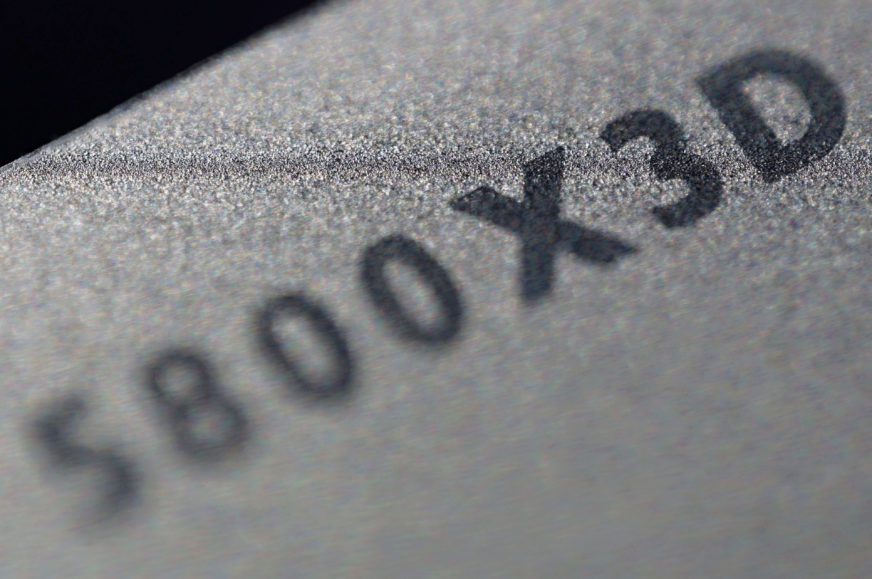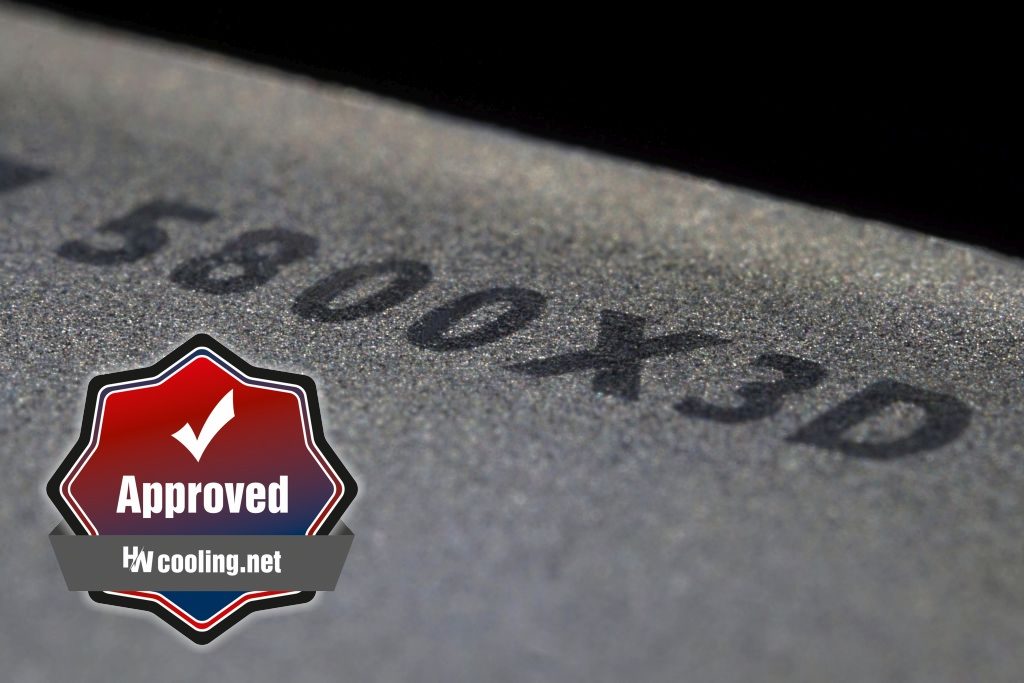Conclusion
AMD’s first processor with 3D V-cache is a rather controversial piece of hardware. Sure, it may be the ultimate in gaming performance, but the desired effect is more “on paper” than practical, and when it does come, it’s in very rare cases. So that you don’t end up disappointed with a virtually single-purpose processor that may not even excel at gaming, we’ve broken it all down in detailed tests.
Conclusion
So let’s get to it. In “synthetic” settings at 720p resolution, the Ryzen 5800X3D is at the very top, and it beats the Core i9-12900K in games at significantly lower power draw. The increase in gaming performance over the R7 5800X (with +250 MHz) is up to 12 %, so that 3D V-cache really works. However, at a more practical 1080p resolution across multiple games, the R7 58003XD already falls below the faster Ryzen 9 (5900X and 5950X) with more cores in terms of average fps.
What’s noteworthy, however, is that despite this, higher minimum fps are achieved with the R7 5800X3D. Here (in Full HD), the Ci9-12900K still trails from second place. At QHD resolution, which is perhaps even closer to being used with such an expensive processor, the R7 5800X3D, with the exception of the R5 5600X, is already below all of the Zen 3 processors with higher frequency gaming all-core boost. In Ultra HD (2160p), the Ryzen 7 results with 3D V-Cache are even below the Core i7-11700KF, on par with the Ryzen 5 5600.
In the case of the Ryzen 7 5800X3D processor evaluation, the mix of games from which relative aggregate performance is calculated is more important than usual. It wouldn’t be that difficult to find ten games that benefit significantly more with 3D V-Cache at 1080p and 1440p than the other ten. When analyzing the R7 5800X3D’s performance in games, it’s useful to go down to the level of individual titles. There are some where the benefit of 3D V-Cache is very little to none, but there are also some for which the processor is really worth it. Relatively measly improvement is typically in CS:GO, in DOOM Eternal, but also in Total War Saga: Troy. In these games, the R7 5800X3D is below the faster R7 5800X. The larger L3 cache size is almost irrelevant.
But then there are also games where 3D V-Cache makes a lot of sense, but only at low resolution with low graphical detail. So in situations where practically everything is now up to the CPU. In Borderlands 3, the R7 5800X3D outperforms the R7 5800X by 23 %, in Cyberpunk 2077 by 30 %, in Shadow of the Tomb Raider by 33 % and up to 47 % in Microsoft Flight Simulator. This is also the only one of the test games where there is a fairly dramatic increase in performance even at higher resolutions. In 1080p it’s (compared to R7 5800X) 34 %, in 1440p it’s only 8 %, but with less fluctuation in minimum fps (from this point of view it’s +20 %) and more stable frame times in general. Performance then levels off (with the R7 5800X) only in Quad HD, where the CPU does minimal work. The improvement with the R7 5800X3D is a bit more pronounced in builds with weaker graphics cards, which will force you to downgrade graphics details in addition to resolution. However, that’s a rather discrepant situation for a configuration with such an expensive processor to be significantly lacking in GPU performance.
In Full HD (i.e. typically on high-speed monitors), 3D V-Cache scores high in Cyberpunk 2077, for example, in F1 2020 or in Shadow of the Tomb Raider. It’s not a big difference, it’s typically under 5 % (although in SOTTR it’s up to 10 %), but the presence of a larger cache still outweighs the higher clock speeds, as gaming performance with the R7 5800X3D is never lower than with the R7 5800X. The tables start to turn against the R7 5800X3D in Assassin’s Creed: Valhalla, for which higher all-core boost clock speeds are better.
The non-gaming, application performance is rather unimpressive with the Ryzen 7 5800X3D. The latter does not usually benefit from a large L3 cache, and the results point more to a lower core clock speeds. This is the casefrom simple office activities, performance in web environments/a>, through working with raster and vector graphics, with photos to video editing or even hard workloads such as 3D rendering or video encoding. Ryzen 7 5800X3D’s performance almost always ends up below the R7 5800X. It should be noted, however, that the processor with 3D V-cache is more efficient. For 3D rendering, it falls some 8 % behind in performance, but that’s with 33 % lower power draw. The 5800X3D’s power draw is the same as the Ci5-12400, only the Ryzen 7 is 17 % more powerful. Despite that lower performance the efficiency (performance per watt) for those less aggressive clock speeds is decent, but it”s not enough to beat the R7 5700X (it’s a more efficient processor). But when it comes to x264 video encoding, the R7 5700X is close on its heels. The efficiency of the R7 5800X3D is higher than that of the R5 5600 or the older Ryzen 7 3700X (Zen 2). The difference compared to the R7 5800X is considerable. Of course in favor of the R7 5800X3D.
It’s also important to note that the R7 5800X3D is the most power-efficient of the 105 W TDP Ryzen 5000 processors. While all other models are around PPT (~140 W) without power limits, the R7 5800X3D has about 25 W less. This is probably also in part to make it possible to keep it cooled at all.Although the Ryzen 7 5800X3D is significantly more power-efficient than the R7 5800X, it heats up a bit more, and it’s already approaching 90 °C. In a gaming workload it’s naturally less, but even there it gets above 70 °C even with powerful coolers. Lower temperatures than Ryzen 9 or R7 5800X are achieved by R7 5800X3D only in single-threaded load. This is because of lower ST boost frequencies, overall lower computational power as well as less heat concentration per unit of area.
The concept with a large 3D V-Cache definitely has potential, but in the form of the Ryzen 7 5800X3D we still see an “experimental” phase and, most importantly, a lot of room for improvement.
English translation and edit by Jozef Dudáš
| AMD Ryzen 7 5800X3D |
| + Large 3D V-Cache with 96 MB |
| + Possible peak gaming performance... |
| + ... theoretically the highest you can currently get |
| + Often lower minimum fps drops with more stable frame times than CPUs with smaller caches |
| + High performance per clock (IPC) |
| + High efficiency (impressive performance per watt) |
| + Significantly more power efficient than Ryzen 7 5800X... |
| + ... and the most power-efficient processor among the Ryzen 5000 with a TDP of 105 W |
| + Advanced 7nm manufacturing process |
| - Many games won't appreciate the large L3 cache. Higher clock speeds, which are lacking, will weigh more |
| - Usually only average gaming performance at higher resolutions |
| - Poor price/multi-threaded performance ratio |
| - Low single-threaded performance in its price class |
| - Very high temperatures for an AMD processors... |
| - ... hard to cool when running quietly even with powerful tower coolers |
| - No integrated graphics |
| Approximate retail price: 449 EUR |
Games for testing are from Jama levova
Special thanks to Blackmagic Design (for a DaVinci Resolve Studio license), Topaz Labs (for licenses for DeNoise AI, Gigapixel AI and Sharpen AI) and Zoner (for Photo Studio X license)
- Contents
- AMD Ryzen 7 5800X3D in detail
- Methodology: performance tests
- Methodology: how we measure power draw
- Methodology: temperature and clock speed tests
- Test setup
- 3DMark
- Assassin’s Creed: Valhalla
- Borderlands 3
- Counter-Strike: GO
- Cyberpunk 2077
- DOOM Eternal
- F1 2020
- Metro Exodus
- Microsoft Flight Simulator
- Shadow of the Tomb Raider
- Total War Saga: Troy
- Overall gaming performance
- Gaming performance per euro
- PCMark and Geekbench
- Web performance
- 3D rendering: Cinebench, Blender, ...
- Video 1/2: Adobe Premiere Pro
- Video 2/2: DaVinci Resolve Studio
- Graphics effects: Adobe After Effects
- Video encoding
- Audio encoding
- Broadcasting (OBS and Xsplit)
- Photos 1/2: Adobe Photoshop and Lightroom
- Photos 2/2: Affinity Photo, Topaz Labs AI Apps, ZPS X, ...
- (De)compression
- (De)cryption
- Numerical computing
- Simulations
- Memory and cache tests
- Processor power draw curve
- Average processor power draw
- Performance per watt
- Achieved CPU clock speed
- CPU temperature
- Conclusion











You have the 5800x’s launch price as $299 when it was actually the same as the 5800x3d’s at $450. You have the 5800x as coming with a AMD Wraith Stealth cooler when it didn’t come with a cooler. These are just things that immediately stood out to me and I haven’t checked further. The article seems fairly detailed, but apparently with the wrong details and I have to ask myself why such obvious things are wrong. There’s a reason why these details are wrong that appear to me to not be because of simple mistakes. It’s almost like you’re going out of your way to make the 5800x3d look bad.
Thanks for the heads up, you are correct, we have two factual errors in the chart. But I’m sure it would be a big mistake to condemn the rest of the article because of them. I make charts at the end, often at the end of my rope. It is very difficult to edit such a voluminous article with so much information, especially considering how small the editorial team is (tests of much larger editorial offices are usually a quarter the size of ours…). So now and then a mistake can happen. The Wraith Stealth cooler in the R7 5800X specs is an error that was caused by cloning the chart from a non-X model, after which the cooler was left there due to an oversight.
And yes, the launch price of the R7 5800X, of course, is not 299 USD, but 449 USD. So yes, this information was also incorrect in the original chart, but know that the goal was definitely not to put R7 5800X3D at a disadvantage. Again, I’ll explain how this came about. In all tests we use the same template and in the R7 5800X test we have something like “Launch price:
449299 USD” in the chart, which hopefully makes it clear that the crossed out price is the launch price and the second amount is the price after discounting. Here the amount dropped out and it looks really strange, but at the same time at the time of writing the article 299 USD corresponded to the suggested price (the one after discounting) by AMD. In order to make everything right, we’re putting back the original wording “449299 USD” with a note (below the chart) that explains that this is the price after discounting, which we’re reflecting. It would be impractical to work with the same launch price of the R7 5800X and the R7 5800X3D in the test case, as the market situation is different.So hopefully it makes a little more sense to you and you will reconsider that this could perhaps be deliberate manipulation. Everything has been corrected and thank you again for your observation and for reading carefully.